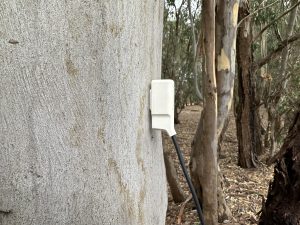Urban Trees.
Urban Trees, Heat Islands, and the Role of Sap Flow Technology.
Urbanisation has led to a significant transformation of landscapes worldwide, with the proliferation of concrete jungles and towering skyscrapers. While these developments have brought about numerous benefits, they have also given rise to a pressing environmental issue: urban heat islands (UHIs). These UHIs are areas within urban environments that experience significantly higher temperatures than their rural or natural counterparts due to the absorption and retention of heat by buildings and pavements. As heatwaves become more frequent and severe due to climate change, addressing the heat island effect is paramount. Urban trees play a crucial role in mitigating these challenges by actively participating in processes like transpiration and sap flow. In this article, we delve into the intricate relationship between sap flow in urban trees and their role in mitigating heatwaves while enhancing cooling in urban environments.
Sap Flow in Trees.

Urban Trees, Heat Islands, and the Role of Implexx Sap Flow Technology
Sap flow, the movement of water and nutrients within a tree, is a fundamental physiological process that supports a tree's growth and sustenance. Trees are not just passive entities in the urban landscape; they are dynamic organisms that actively contribute to their surroundings. Understanding sap flow dynamics in urban trees is crucial for harnessing their cooling potential.
Transpiration, the release of water vapour through tiny openings called stomata on a tree's leaves, is a major component of sap flow. This process serves as a natural cooling mechanism for trees. As water is drawn up from the roots through the xylem, it cools the tree and the surrounding air when it is released into the atmosphere through transpiration. This cooling effect is akin to our body's sweat, helping trees regulate their temperature.
Sap Flow and Heatwaves.
Heatwaves are becoming more frequent and intense due to climate change. During these periods, urban areas experience soaring temperatures, leading to discomfort, health issues, and increased energy consumption for cooling. Urban trees, by facilitating sap flow and transpiration, can act as nature's air conditioners, mitigating the impact of heat waves.
During a heatwave, the cooling effect of trees through transpiration becomes especially critical. As trees release water vapor, they not only lower their own temperature but also reduce the ambient air temperature in their vicinity. This localised cooling effect can be significant, providing respite to urban dwellers and reducing the overall energy demand for air conditioning.
Transpirational cooling during heat waves has been observed in many studies. For example, Forster and Englefield (2021) noted transpirational cooling supported grapevine health during a heatwave, and Drake et al. (2018) noted similar effects for eucalypt trees.
Urban Trees as Heat Island Mitigators.
Urban trees play a multifaceted role in mitigating the urban heat island effect, as noted by studies in Japan, Italy and elsewhere. Firstly, their shade reduces the absorption of solar radiation by buildings and pavement, thereby lowering surface temperatures. Secondly, their cooling effect through transpiration contributes to cooler microclimates. Thirdly, the presence of trees promotes natural ventilation by breaking up wind patterns, which can further reduce heat accumulation in certain areas.
It is important to note that not all tree species are equally effective at mitigating heat. Choosing the right tree species, considering factors like drought tolerance and canopy density, is crucial for optimising their cooling potential. Proper tree planting and maintenance practices are essential to ensure their long-term survival and effectiveness in urban heat mitigation.
Sustainable Urban Planning.
Incorporating trees and green infrastructure into urban planning is a key strategy for combatting heat waves and enhancing cooling in cities. Researchers and urban planners are increasingly recognising the importance of maintaining and expanding urban tree canopies as a cost-effective and sustainable solution.
One noteworthy example is the Million Trees NYC initiative, which aims to plant one million new trees across New York City, USA. Another example is the plan for 170,000 trees across Paris, France, to address the effects of heatwaves. Similar programs are being implemented in cities around the world to increase urban tree cover and combat rising temperatures. These initiatives not only provide immediate cooling benefits but also contribute to long-term climate resilience.
Urban Heat Island Explained.
Challenges and Future Directions.

Advanced technologies such as remote sensing and urban heat mapping can assist in identifying high-impact areas for tree planting and maintenance.
While urban trees are powerful allies in the fight against heatwaves and urban heat islands, they face several challenges in urban environments. These include limited space for growth, soil compaction, pollution, and the effects of climate change itself, such as drought stress. To harness the full potential of urban trees, it is essential to address these challenges through innovative solutions like urban forestry management, green roof technologies, and soil improvement practices.
Furthermore, ongoing research into the specific sap flow dynamics of urban trees and their response to changing environmental conditions will help refine urban planning strategies. Incorporating advanced technologies such as remote sensing and urban heat mapping can assist in identifying high-impact areas for tree planting and maintenance.
In conclusion, understanding the role of sap flow in urban trees and its contribution to mitigating heat waves and enhancing cooling is critical in the context of urbanisation and climate change. Urban trees are not passive bystanders; they are dynamic agents of change that can significantly improve the livability of cities. Sustainable urban planning, tree planting initiatives, and ongoing research are essential components of harnessing the cooling potential of urban trees. By recognising the value of these green giants in our cities, we can create more comfortable, resilient, and sustainable urban environments for generations to come.
Related Products.
